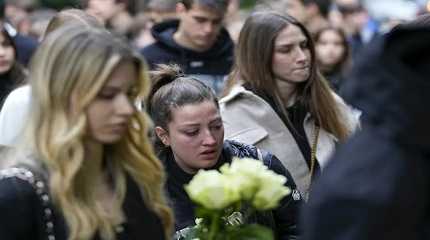
BELGRADE, Serbia (AP) — Serbian police on Thursday urged citizens to lock up their guns after a 13-year-old boy used his father’s guns in a shooting rampage that killed eight of his fellow students and a school guard, sending shock waves through the nation.
Thousands of people in Belgrade and other cities throughout the Balkan country lined up to lay flowers, light candles and leave toys to commemorate the victims of the shooting that happened in a central district in the Serbian capital on Wednesday morning.
Many people cried and hugged outside the school as they stood in front of heaps of flowers, small teddy bears, a gray and pink toy elephant and a girl’s ballet shoes hung on the fence. Students from other Belgrade schools also came to the site in groups, standing in silence.
Police said the teenager had planned the attack for a month, drew sketches of classrooms and made lists of children he planned to kill. The boy, who had visited shooting ranges with his father, took two guns from his father’s safe, police said on Wednesday.
Serbia is awash with weapons left over from the wars of the 1990s but mass shootings still have been extremely rare — this is the first school shooting in Serbia’s modern history.
“The Ministry of Interior is appealing to all gun owners to store their guns with care, locked up in safes or closets so they are out of reach of others, particularly children,” police said in a statement that also announced tightened controls on gun owners in the future.
The shooting on Wednesday morning in Vladislav Ribnikar primary school also left seven people hospitalized — six children and a teacher. One girl who was shot in the head remains in a life-threatening condition, and a boy is in serious condition with spinal injuries, doctors said on Thursday morning.
To help people deal with the tragedy, authorities announced they were setting up a helpline. Hundreds answered a call to donate blood for the wounded victims. A three-day mourning period will begin Friday morning.
Serbian teachers’ unions announced protests and strikes to demand changes and warn about a crisis in the school system. Hundreds of students and their parents protested in front of the education ministry, demanding resignations.
The shooter, whom the police identified as Kosta Kecmanovic, has not given any motive for his actions.
Upon entering his school, Kecmanovic first killed the guard and three students in the hallway. He then went to the history classroom where he shot the teacher before turning his gun on the students.
Kecmanovic then unloaded the gun in the school yard and called the police himself, although they had already received an alert from a school official. When he called, Kecmanovic told duty officers he was a “psychopath who needs to calm down,” police said.
Those killed were seven girls, one boy and the school security guard. One of the girls was a French citizen, France’s foreign ministry said.
Authorities have said that Kecmanovic is too young to be charged and tried. He has been place in a mental institution while his father has been detained on suspicion of endangering public security because his son got hold of the guns.
“I think we are all guilty. I think each one of us has some responsibility, that we allowed some things we should not allow (to happen),” said Zoran Sefik, a Belgrade resident, during Wednesday evening’s vigil near the school.
Gun culture is widespread in Serbia and elsewhere in the Balkans: The region is among the top in Europe in the number of guns per capita. Guns are often fired into the air at celebrations and the cult of the warrior is part of national identity. Still, the last mass shooting was in 2013 when a war veteran killed 13 people in a central Serbian village.
While such attacks are rare, experts have repeatedly warned of the danger posed by the number of weapons in a highly divided country, where convicted war criminals are glorified and violence against minority groups often goes unpunished. They also note that decades of instability stemming from the conflicts of the 1990s as well as ongoing economic hardship could trigger such outbursts.
“We have had too much violence for too long,” psychologist Zarko Trebjesanin told N1 television. “Children copy models. We need to eliminate negative models ... and create a different system of values.”




